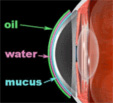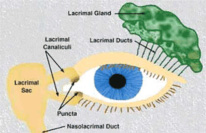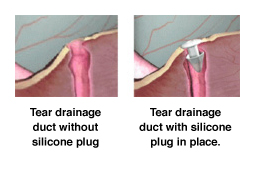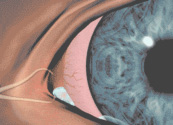Dry Eyes
-
What Is Dry Eye?
-
Symptoms of Dry Eye
-
Normal Tear Film
-
Causes of Dry Eye
-
How Is Dry Eye Diagnosed?
-
How Is Dry Eye Treated?
What Is Dry Eye?
Some people do not produce enough tears or the appropriate quality of tears to keep the eye healthy and comfortable. This is known as dry eye.
Tears are produced by two different methods. One method produces tears at a slow, steady rate and is responsible for normal eye lubrication. The other method produces large quantities of tears in response to eye irritation or emotions.
Tears that lubricate are constantly produced by a healthy eye. Excessive tearing occurs when the eye is irritated by a foreign body, dryness or when a person cries.
Symptoms of Dry Eye:
- stinging or burning eyes
- scratchiness
- stringy mucus in or around the eyes
- excessive eye irritation from smoke or wind
- excess tearing
- difficulty wearing contact lenses
Excess tearing from "dry eye" sounds illogical, but if the tears responsible for maintenance lubrication do not keep the eye wet enough, the eye becomes irritated. When the eye is irritated, the lacrimal gland produces a large volume of tears that overwhelm the tear drainage system. These excess tears then overflow from your eye.
Normal Tear Film:
A film of tears, spread over the eye by a blink, gives the eye a glassy smooth optical surface. Without a healthy tear film, good vision is not possible.
The tear film consists of three layers:

1. AN OILY LAYER - produced by the eyelid's meibomian glands, forms the outermost surface of the tear film. Its main purpose is to smooth the tear surface and reduce evaporation of tears.

2. A WATERY LAYER - The middle watery layer makes up most of what we ordinarily think of as tears. This layer, produced by the lacrimal gland, cleanses the eye and washes away foreign particles or irritants.

3. A LAYER OF MUCUS - The inner layer consists of mucus produced by the conjunctiva, the paper-thin mucous membrane that covers the surface of the eyeball. Mucus allows the watery layer to spread evenly over the surface of the eye and helps the eye remain moist. Without mucus, tears would not stick to the eye.
Causes of Dry Eye:
Tear production normally decreases as we age. Although dry eye can occur in both men and women at any age, women are most often affected. This is especially true after menopause.
Dry eye also can be associated with other problems. For example, people with dry eyes, dry mouth and arthritis are said to have Sjogren's syndrome.
A wide variety of common medications, prescriptions and over-the-counter can cause dry eye by reducing tear secretion.
Be sure to tell your ophthalmologist the names of all the medications you are taking, especially if you are using:
- diuretics;
- beta-blockers;
- antihistamines;
- sleeping pills;
- medications for "nerves";
- pain relievers.
How Is Dry Eye Diagnosed?
Our eye doctors usually are able to diagnose dry eye by examining the eyes. Sometimes tests that measure tear production may be necessary. One test, called the Schirmer tear test, involves placing filter-paper strips under the lower eyelids to measure the rate of tear production under various conditions. Another uses a diagnostic drop (fluorescein) to look for certain patterns of dryness on the surface of the eye.
How Is Dry Eye Treated?
Adding Tears
Eye drops called artificial tears are similar to your own tears. They lubricate the eyes and help maintain moisture.
Artificial tears are available without a prescription. There are many brands on the market, so you may want to try several to find the one you like best.
Preservative-free eye drops are available if you are sensitive to the preservatives in artificial tears. If you need to use artificial tears more than every two hours, preservative-free brands may be better for you.
You can use preservative-free tears as often as necessary; once or twice a day or as often as several times an hour.
Conserving the Tears
Conserving your eyes' own tears is another approach to keeping the eyes moist.
Tears drain out of the eye through a small channel into the nose (which is why your nose runs when you cry). Our eye doctors may close these channels either temporarily or permanently. The closure conserves your own tears and makes artificial tears last longer.

A tear plug is in place in the lower eyelid drainage duct. Natural tears are retained rather than drained away, allowing more natural lubrication for the eye.

Other Methods
Tears evaporate like any other liquid. You can take steps to prevent evaporation. In winter, when indoor heat is on, a humidifier or a pan of water on the radiator adds moisture to dry air. Wrap-around glasses may reduce the drying effect of the wind. Anything that may cause dryness, such as an overly warm room, hair dryers or wind, should be avoided by a person with dry eye. Smoking is especially bothersome.
Some people with dry eye complain of "scratchy eyes" when they wake up. This symptom can be treated by using an artificial tear ointment or thick eye drops at bedtime. Use the smallest amount of ointment necessary for comfort, since the ointment can cause your vision to blur.

